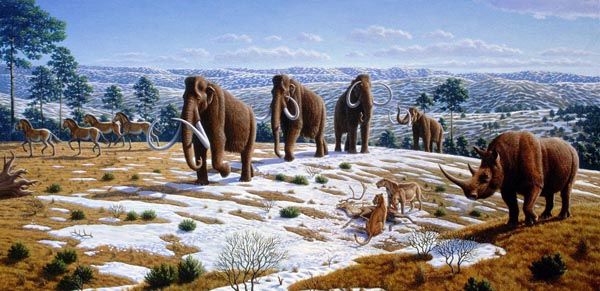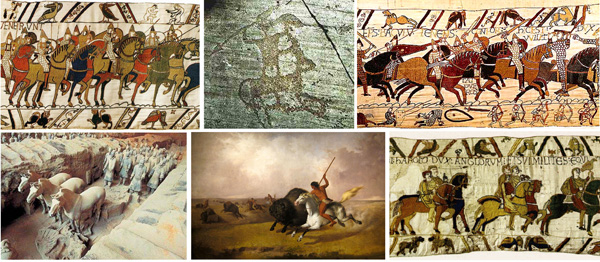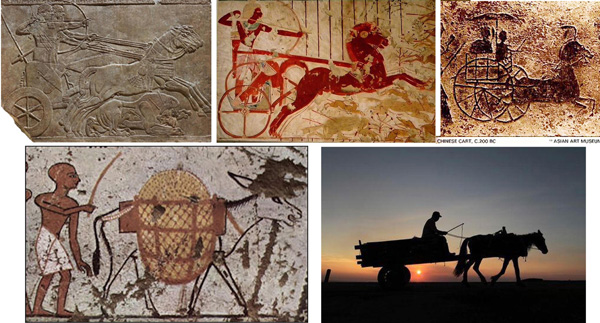History of the Horse – Part 11
|
|
Geschichte des Pferdes – Teil 11
|
Holocene
- The period, which started about 10,000 years ago, is called Holocene. It comprises the end of last major glacial epoch as already since about 16,000 years ago there was a slow warming of the climate.
|
|
Holozän
- Der Zeitabschnitt, der vor 10.000 Jahren began, heißt Holozän. Er umfaßt das Ende der letzten großen Eiszeit vor 16 000 Jahren und dann ein langsames Erwärmen des Klimas.
|
 At the end of the ice age all Megafauna died out.
Am Ende der Eiszeit starben die Riesentiere aus.
|
- About 13,000 years ago, more than three-fourths of the large Ice Age animals, including wooly mammoths, mastodons, saber-toothed tigers and giant bears, died out. Scientists have debated for years over the cause of the extinction. Neither climate change nor human hunting quite explains it (wiping out animals by the millions, as the poor bison had to experience later, was only possible to humans once firearms were invented). Recent research suggests that an extraterrestrial object, possibly a comet, may have exploded over southern Canada, nearly wiping out an ancient Stone Age culture as well as mega-fauna like mastodons and mammoths.
- About 8000 years ago horses died out in North America. But in the rest of the world the history of the horses now becomes interesting in a totally new manner – humans set out to domesticate them!
Domestication of the Horse:
- Domestication is the process by which humans take wild animals and acclimatize them to living and breeding in captivity. We know that dogs were tamed a long time before horses, about 15,000 years ago, sheep 10,000 years and pigs and cattle about 8,000 years ago.
- WHEN horses were truly domesticated depends also on what we mean by it: do we mean that humans kept them in pens as a meat supply and for milking? Or started to control their breeding? Or that horses were now trained for work?
|
|
- Vor etwa 13 000 Jahren starben mehr als drei Viertel der großen Eiszeit Tiere aus, wie das Mammut, die Mastodons, Säbelzahntiger und Riesenbären. Wissenschaftler diskutieren den Grund für dieses Aussterben schon lange. Weder Klimawandel noch vermehrtes Jagen der Menschen können es erklären (das millionenfache Abschlachten von Tieren, wie es die armen Bisons später erleiden mußten, war ja erst nach Erfindung von Feuerwaffen möglich). Neuere Forschung legt nahe, daß vielleicht ein außerirdisches Objekt, etwa ein Komet, damals über Südkanada explodiert ist, und damit fast die ganze Steinzeitkultur und die Megafauna zerstört hat.
- Vor 8000 Jahren starben in Nordamerika die Pferde aus. In der restlichen Welt aber wird ihr Leben nun erst richtig interessant – denn die Menschen fangen an sie zu zähmen!
Domestizierung der Pferde:
- Domestizierung ist der Prozess bei dem Menschen wilde Tiere zähmen und sie an ein Leben und an Fortpflanzung in der Gefangenschaft gewöhnen. Wir wissen, daß Hunde lange vor den Pferden gezähmt wurden, vor etwa 15 000 Jahren, Schafe vor 10 000 und Schweine und Rinder vor 8000.
- WANN Pferde wirklich domestiziert waren, hängt auch von der Definition ab: meinen wir damit, daß sie als Fleischvorrat und zum Melken in einem Pferch gehalten wurden? Oder daß die Zucht schon beeinflußt wurde? Oder daß Pferde zur Arbeit eingesetzt werden konnten?
|
|

|
- How humans could draw 30,000 years ago !!
- We know from the Paeolithic cave art as early as 30,000 BC that humans had contact with horses, but these were truly wild horses and were hunted for meat. The clearest evidence that the horse was used as a means of transport – as beast of burden, or drawing chariots, which we know from burial sites – is dated c. 2000 BC. But probably horses were domesticated in the Eurasian steppes as early as 4000–3500 BC.
Difficult to determine by DNA:
- What makes it difficult to determine exactly when we started to have “domesticated horses” is the fact that one can’t clearly define this by DNA samples of physical remains found, as there was no true separation of the genotypes of domesticated and the feral populations. As long as the horses in captivity were kept within the habitat of the wild population, there was a natural flow between the gene pools. Even now, all modern horse populations retain the ability to revert to a feral state, and all wild horses are of domestic types (they descend from ancestors that escaped from captivity).
- Understanding the genetic changes involved in equine domestication (from about 5,500 years ago) is interesting, because of the important role that taming wild horses played in the development of civilization.It was all made possible by 125 genes – related to skeletal muscles, balance, coordination, and cardiac strength. The result of selective breeding was generations of horses adapted for chariotry, pulling plows, and racing.
|
|
- Wie Menschen schon vor 30 000 Jahren zeichnen konnten !!
- Wir wissen von Paeolitischen Höhlenzeichnungen, daß Menschen schon 30 000 Jahre vor Chr. Kontakt zu Pferden hatten, aber diese waren wirklich wild und wurden für Fleisch gejagt. Der klarste Beweis, daß Pferde als Transportmittel benutzt wurden – als Lasttier, vor dem Wagen usw., was wir aus Grabfunden wissen – liegt um 2 000 Jahren vor Chr. In den Eurasischen Steppen wurden Pferde aber vermutlich schon 4000–3500 v. Chr. gezähmt.
Schwierigkeiten bei der DNA Bestimmung:
- Durch DNA Untersuchungen zu bestimmen, wann genau die Pferde domestiziert waren, ist schwierig. Es gibt zwar Funde, die man dazu benutzen kann, aber es gab damals keine klare Trennung der Genotypen zwischen gezähmten und wilden Tieren. Solange gezähmte Tiere mit den wilden gemischt gehalten wurden, gab es einen natürlichen Austausch zwischen den Erbmassen. Auch heute noch haben ja unsere Pferde die Fähigkeit wieder zu verwildern, und alle jetzt noch wilden Pferde stammen von Vorfahren ab, die aus der Gefangenschaft entflohen sind.
- Es ist interessant die genetischen Veränderungen während der Domestikation (ab etwa vor 5 500 Jahren) zu verstehen, da die Zähmung der Pferde so einen umwerfenden Einfluß auf die Entwicklung unserer Zivilisationen gehabt hat. All das wurde möglich durch 125 Gene, die die Muskeln, Balance, Koordination und Herzausdauer regeln. Das Ergebnis des selektiven Züchtens von Generationen von Pferden war dann die Eignung fürs Fahren, Ziehen und Rennen.
|
|
|
- Genes active in the brain determine social behavior, learning, fear response, and agreeableness– and those are all more abundant in domesticated horses than in feral ones. The discovery of the genetic basis for horse domestication was slow because no wild descendants of ancient breeds survive. The closest is the Przewalski’s horse.
|
|
- Gene im Gehirn bestimmen soziales Verhalten, Lernfähigkeit, Angstreaktionen und angenehmes Wesen – und all diese sind in domestizierten Pferden in größerer Anzahl vorhanden als in wilden! Die Entdeckung dieser genetischen Basis war kompliziert, da keine der wirklich wilden Arten überleben. Beim Przewalski Pferd kommt man der Sache noch am nächsten.
|
 Left a Tarpan Horse, mid wild horses from Hungary, right a Przewalski Horse.
Links ein Tarpan Pferd, Mitte Wildpferde in Ungarn, rechts ein Przewalski Pferd. |
- With no truly wild horses to study, scientists examined DNA from 29 horse bones discovered in the Siberian permafrost and dating from 16,000 and 43,000 years ago, and compared it to DNA from five modern domesticated breeds. Interesting: some genes in today’s horses were absent altogether from the ancient ones, showing they arose from recent mutations. Among them: a short-distance “speed gene” that propels every Kentucky Derby winner. So: flight is natural – racing is NOT!
How did the idea of taming horses arise?
- It is supposed that when humans hunted horses for meat they might have (in one of their gentler moments) taken some orphaned foals home as pets. Once hand-raised and tame it was discovered that they could be used for work. (Maybe they had already tamed some cattle before).
Since when did humans ride?
- When nomads started keeping horses in herds, they could really only keep such a herd together from horseback – so domestication and riding probably went hand in hand. From finds of horses buried in human graves and from artifacts, where they appear frequently as symbols of power, we know that from at least 2000 BC on horses and humans were closely connected in their lives. But as of 4000 BC there is evidence in the dental remains found in horses that they were now “bitted” – of course people could have used bits also for pulling animals or have ridden much earlier on without bits, so that this alone cannot determine the beginning of riding precisely.
|
|
- Da man keine wirklich wilden Pferde mehr erforschen kann, haben Wissenschaftler DNA aus 29 Pferdeknochen gewonnen, die im siberischen Dauerfrostboden gefunden wurden (datiert als 16 000 und 43 000 Jahre alt) und das verglichen mit DNA von fünf modernen Pferdearten. Interessant: manche Gene der heutigen Pferde sind in den wilden gar nicht vorhanden, woraus man schließen kann, daß sie aus gezüchteten Mutationen hervorgehen. Eins davon: das „Sprinter Gen“, das jeder Kentucky Derby Gewinner haben muß. Also: Flucht ist natürlich – Rennen sind es nicht!
Wie kam man auf die Idee Pferde zu zähmen?
- Man könnte sich denken, daß Pferdefleischjäger in einem ihrer „menschlicheren“ Momente vielleicht verwaiste Fohlen als Spieltiere mit nach Hause nahmen. Wenn die zahm aufgewachsen waren erkannte man vielleicht, daß man sie auch zur Arbeit nutzen konnte. (Vielleicht wurden ja auch schon vorher Rinder gezähmt).
Seit wann reiten die Menschen?
- Als die Nomaden anfingen Pferde in Herden zu halten, konnten sie solche Herden eigentlich nur vom Pferderücken aus zusammenhalten – man kann also annehmen, daß die Domestikation und das Reiten Hand in Hand gingen. Aus Grabfunden mit menschlichen und Pferdeüberresten, wo diese oft als Machtsymbol beigefügt waren, wissen wir, daß Mensch und Pferd mindestens seit 2000 Jahren vor Chr. eng in ihrem Leben miteinander verbunden waren. Seit 4 000 vor Chr. gibt es Beweise in Zahnüberresten, daß von nun ab Gebisse benutzt wurden. Natürlich konnte man diese auch bei Zugtieren einsetzen – und ebenso kann man ohne Gebiß reiten, so daß dies nicht genau den Zeitpunkt des ersten Reitens festlegen kann.
|
|

|
A means of traction and transport:
- It is the docile and congenial nature of horses and their speed that made them so special and useful to humans. If needs be, oxen could pull the plough or a wagon – but before the invention of the steam engine, riding a horse was simply the fastest way to get around!
- Once merchants, soldiers and explorers could gallop rather than just walk, it revolutionized trade, warfare, the movement of people and the transmission of ideas. It also enabled the development of continent-sized empires such as the Scythians 2,500 years ago!
- And let us not forget that even today the horse (and donkeys and mules) plays a vital role in earning a livelihood for millions of people in the developing world. (Read the material of the Brooke Foundation about the plight of the “kiln donkeys” and horses in such countries as Afghanistan, the Middle East and India). (www.thebrooke.org)
When did first breeding attempts start?
- At the end of the ice age there was only one kind of horses left, the Equus Ferus, which had two sub-species: the Tarpan in Eastern Europe, and the Przewalski Horse in inner Asia.
- About 2500–2000 BC, we first see changes in the sizes and the variation of horse appearance, which suggests that humans started to breed them according to their wishes. For the long periods before they probably caught wild horses (and “broke” them) for use – because initially humans must have had great difficulties in keeping horses and make them procreate in captivity.
- Those wild stallions were WILD – and they don’t just mate with anyone either. Humans had to develop quite a bit of knowledge about horses: in order to breed wild horses successfully in captivity, their environmental, nutritional and social requirements must be met. Knowing humans we can also assume that stealing already domesticated horses from the neighbouring tribes was great sport and easier than breeding them!
- As soon as humans could ride, they became high and mighty – it seems to be human nature. It made them fast and powerful – they could fight better! How they used horses as partners in this favourite pastime, we will learn in the next Blog!
Read on !!
|
|
Das Pferd als Transportmittel und Zugtier:
- Es ist die gelehrige und freundliche Natur des Pferdes und seine Geschwindigkeit, die es dem Menschen so besonders nützlich gemacht hat. Man konnte den Wagen ja auch von Ochsen ziehen lassen – vor der Erfindung der Dampfmaschine war das Pferd aber einfach die schnellste Art und Weise sich fort zu bewegen!
- Sobald Händler, Krieger und Erforscher gallopieren konnten statt zu laufen, gab es eine wahre Revolution im Handel und in der Kriegsführung, in der Fortbewegung der Menschen generell und damit in der Verbreitung von Ideen. Es machte die Entwicklung von riesigen Reichen, wie das der Scythen vor 2 500 Jahren überhaupt erst möglich!
- Wir sollten auch nicht vergessen wie selbst heute noch in der dritten Welt das Pferd (und Esel und Maultiere) für Millionen Menschen das tägliche Leben bestimmen. (Lesen Sie das Material der Brooke Foundation über das harte Leben der Esel und Pferde in Ländern wie Afghanistan, dem mittleren Osten und Indien). (www.thebrooke.org)
Wann machten Menschen die ersten Zuchtversuche?
- Am Ende der Eiszeit gab es nur noch eine Art Pferd, das Equus Ferus, das zwei Unterarten hatte: das Tarpan Pferd in Osteuropa und das Przewalski Pferd in Innerasien.
- Vor 2 500 bis 2 000 Jahren vor Chr. sieht man zum ersten Mal Veränderungen in der äußeren Erscheinung der Pferde, so daß man annimmt, daß hier die Menschen schon nach ihren eignen Wünschen züchten. Die ganze Zeit davor fing man sich wilde Pferde ein und ritt sie zu – da es anfangs sehr schwierig gewesen sein muß, wilde Pferde in der Gefangenschaft zu vermehren.
- Denn wilde Hengste lassen sich nicht grade nach Wunsch mit jeder Stute paaren. Die Menschen mußten erst viel über Pferde lernen: um sie erfolgreich in der Gefangenschaft zu züchten, müssen ihre Ansprüche an Umwelt, Ernährung und soziale Verhältnisse befriedigt werden. Und wie wir die Menschen kennen, kann man auch annehmen, daß das Stehlen schon gezähmter Pferde von den Nachbarstämmen ein guter Sport und leichter war, als sie selber zu züchten!
- Sobald die Menschen reiten konnten, wurden sie anmaßend – das scheint die menschliche Natur zu sein. Es machte sie schnell und mächtig – so konnte man besser kämpfen! Wie sie Pferde als Partner in dieser so beliebten Beschäftigung nutzten, lesen Sie im nächsten Blog!
Lesen Sie weiter !!
|






